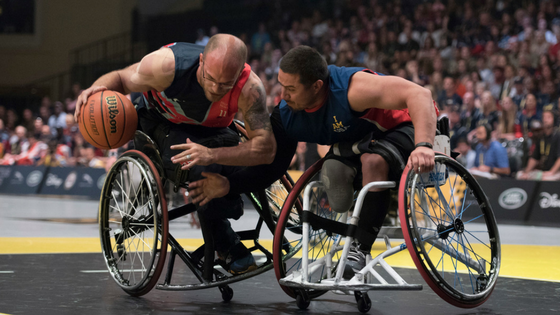WWII Vets and the Birth of a Sport

In the years before World War II, few people survived a serious spinal cord injury and those who did lived out their lives confined to a hospital bed. Fortunately, much of that changed as veterans began returning home from the war having suffered from severe injury.
Advances in medical technology – most notably penicillin and surgical techniques – helped to expand the possibilities for injured WWII veterans. But with advances in medical technologies come new challenges. The veterans who returned from the war faced what they called ‘battle fatigue’ – what today would be clearly seen as PTSD. Flashbacks, survivor’s guilt, and increased substance abuse were all common among WWII vets.
This ‘battle fatigue’ was common with many returning veterans, but especially so with paraplegics. Jerry Fesenmeyer, a soldier injured in the Pacific theater said, “They believed if you had a spinal injury, you weren’t supposed to get out of bed for a year. I laid in that goddamn bed just rotting away.” His frustration is palpable. Veterans like Fesenmeyer faced the difficulties of PTSD, the struggle of coping with a spinal cord injury and navigating life in a pre-ADA world.
The Birth and Rise of a Sport
These young men faced serious challenges – both physical and emotional. And into this situation, a surprising new idea brought hope for these struggling veterans – wheelchair basketball. The idea was born among a group of disabled vets rehabilitating at Birmingham Army Hospital in Van Nuys, CA. From Birmingham Army Hospital, the idea of wheelchair basketball spread to the US Naval Hospital Corona in Norco, CA. And now, with two teams the possibility of competition among these disable vets was born. On March 18, 1947, the Birmingham Charioteers played the fledgling Corona Rolling Devils – and soundly defeated them 20-6. Regardless of the score, a passion for this new sport developed. And it quickly spread from Birmingham and Norco across the country. Soon there were wheelchair basketball teams across the country. In fact, the sport was so popular that able-bodied teams were taking to wheelchairs to play in exhibition games against paraplegic teams. The popularity continued to increase until 1948 when a game impressively sold out Madison Square Garden.More Than a Sport
But wheelchair basketball was more than a sport. It gave purpose and hope to a group that was struggling with so many challenges. This new sport opened a whole new world of ‘purposeful movement’ to treat both the physical and mental struggles of a spinal cord injury. Soon this idea would catch on more broadly and these pioneers of wheelchair basketball would help to bring about the Paralympic Games. At the same time in the United Kingdom, Dr. Ludwig Guttmann was perusing a similar line of treatment. And by 1948 he helped to organize the International Wheelchair Games. By 1960, the first Paralympic Games was held in Rome and attracted 400 athletes from 23 countries. And an entire movement was born. In the 2016 Summer Games held in Rio De Janeiro attracted over 4,300 athletes from 159 nations. From that first wheelchair basketball game in 1947 to today, we have seen a massive shift in the way we treat spinal cord injuries.Changing Lives Through Whole-Patient Care
When Jerry Fesenmeyer first took to the court only weighed 75 pounds and was recovering from severe pressure sores, not to mention the emotional and physiological injuries. But an innovative approach to whole-patient care gave him a new life through caring for his mind, body, and spirit. These Southern California hospitals helped to give birth to a movement that has helped tens-of-thousands of people cope with their spinal cord injuries. Only 75 years ago, an SCI was a life-ending event; today we know that a combination of medical care, physical rehabilitation, and emotional coping can lead to a fulfilling life after a spinal cord injury.
October 26, 2017
|
View: 798
|
Categories: Veterans, Healthy Living
|
Tags: spinal cord injury, U.S. Armed Forces, Veterans, wheelchair












